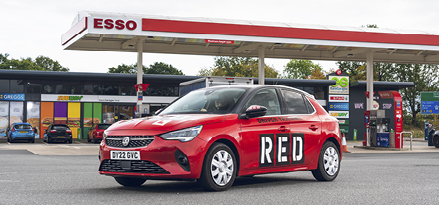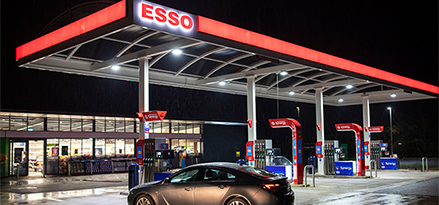As well as the fuel you use, the condition of your car, the routes you take, and the way you drive all make a difference to your fuel economy. And little adjustments can really add up.
Here are some things we’re doing to help:

Low tyre pressure uses more fuel
Car care and maintenance is often at the bottom of the ‘to do’ list, or is something we don’t even really think about until something goes wrong. But there are lots of simple things that everyone can do that can have a big impact on your fuel economy and health of your car – for example, maintaining the correct tyre pressure.
Tyres inflated to a pressure just 6psi below the recommended inflation could produce a 3% increase in fuel consumption, costing over £600 million to UK drivers every year1.
Furthermore, recent research commissioned by Esso found that only half (52%) of Brits check their car’s tyre pressure as soon as the warning light comes on, the research also found that 1 in 5 of us don’t feel confident using a tyre pump either at a service station or at home.2
Keeping your tyres inflated to the correct pressure will help you save fuel. That’s why we teamed up with Kwik Fit and Michelin to encourage UK motorists check their tyre pressure.
Find out more about tyre pressure
Free Fuel Saver check at Kwik Fit
If you’re not feeling confident adjusting your car’s tyre pressure, we’ve teamed up with Kwik Fit to offer Esso customers an exclusive free Fuel Saver check at any Kwik Fit centre. A professional Kwik Fit mechanic will check your tyres and inflate them to the correct pressure. They will also check your oil level and top it up with Mobil oil, if needed, to help your fuel go further. Visit your nearest Esso to book your free Fuel Saver Check.
Book now
RED driving school
As RED Driver Training’s fuel partner of choice we’re on a mission together to power fuel efficient driving around the UK and beyond. We recently challenged eight of RED’s top driving instructors to take part in the Esso Fuel Efficient Driving Challenge, joined by triple Guinness World Record holder for lowest energy consumption driving, Kevin Booker. The mission was simple – who could achieve the lowest overall miles per gallon (MPG) using effective driving techniques whilst driving the same car and route?
The driving instructors achieved an incredible average of 57.5 MPG which is just over 19% higher than
the MPG achieved by regular drivers on the same route (48.2 MPG). Hypermiling legend Kevin Booker achieved a huge 26% improvement on the average driver, using an average of 65.6 MPG.
RED estimates that drivers can make a yearly saving of up to 17% on fuel when integrating effective
driving techniques in their day-to-day journeys, based on an average of 10,000 miles driven per year3.
Kickstart your fuel efficient driving journey today with our free Fuel Efficient Driving Digital Course. The interactive course will guide you through key steps when it comes to getting the most from your fuel, helping you reduce overall emissions.
Take the courseEsso and Oracle Red Bull Racing Fuel Efficiency Challenge
If anyone knows how to make every drop of fuel count it's Max Verstappen and the Oracle Red Bull Racing Formula 1 Team.
We got Max to challenge Red Bull mountain bike athlete Matt Jones to see who is the most economical driver.
As well as having a lot of fun along the way, the aim was to test some of our driving tips and get some inside tricks from the masters of fuel economy.
Here’s a thought
-

Keeping your car topped up with the right engine oil doesn’t just protect your engine from damage, but also reduces your fuel consumption.
Did you know that Mobil 1 ESP X2 0W-20 helps provide up to a 4% fuel efficiency improvement4, equivalent to reducing CO2 emissions associated with charging over 23,000 smartphones5.
Find out more about our Mobil 1 energy efficient engine oils, and don’t forget to check out our free Fuel Saver Check available to Esso customers at Kwik Fit.

Sign up for updates on our latest Thoughtful Driving initiatives
Sign up for our emails to receive inspiring news, offers and fuel-saving ideas.
Sign up nowMore about Thoughtful Driving
2 Censuswide Consumer Research commissioned by Esso in October 2022. Survey of 2,000, aged 18+, holding valid UK drivers licence and own a car.
3 Source https://www.reddrivingschool.com/driver-risk-management/fuel-save-driver-training/
4 Compared with Mobil 1 ESP Formula 5W-30; Actual savings are dependent upon vehicle and engine type, outside temperature and barometric pressure, driving conditions and your current engine oil viscosity
5 Assumes 11,507 miles/yr, 21.7 mpg fuel average, and 4% fuel economy improvement; using US EPA Greenhouse Gas Equivalencies Calculator: https://www.epa.gov/energy/greenhouse-gas-equivalencies-calculator
6 Source KwikFit








